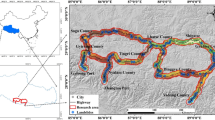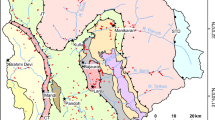Abstract
Rock landslides, one of the most common disasters in an open-pit mine, may occur at any point during the mining process. To manage landslide emergencies and define adequate preventive measures, a two-stage monitoring system was designed in this study to identify the potential landslide area and record multiple real-time data regarding an impending landslide. A case-based reasoning (CBR) approach was then designed to find similar rock landslide cases with detailed geological and monitoring information. The similar cases can provide workable engineering analogies for landslide prediction. Finally, an early warning system including slope stability analysis results, multifactor monitoring data, and early warning indicators obtained by CBR approach was established. Three warning levels were defined to support the system: ordinary “blue” level, attention “yellow” level, and alarm “red” level. A case study in the Dagushan open-pit mine indicates that the proposed system can provide ideas and solutions for rock landslide early warning in similar open-pit mines.














Similar content being viewed by others
References
Ashkan V, Moore L, Ali H (2010) Monitoring systems for warning impending failures in slopes and open pit mines. Nat Hazards 55(2):501–512
Atzeni C, Barla M, Pieraccini M, Antolini F (2015) Early warning monitoring of natural and engineered slopes with ground-based synthetic-aperture radar. Rock Mech Rock Eng 48(1):235–246
Baroň I, Bečkovský D, Míča L (2014) Application of infrared thermography for mapping open fractures in deep-seated rockslides and unstable cliffs. Landslides 11(1):15–27
Bye AR, Bell FG (2001) Stability assessment and slope design at Sandsloot open pit, South Africa. Int J Rock Mech Min Sci 38(3):449–466
Carey J, Moore R, Petley DN (2015) Patterns of movement in the Ventnor landslide complex, Isle of Wight, southern England. Landslides 12(6):1107–1118
Carlà T, Farina P, Intrieri E, Ketizmen H, Casagli N (2018) Integration of ground-based radar and satellite InSAR data for the analysis of an unexpected slope failure in an open-pit mine. Eng Geol 235(13):39–52
Fan YB, Yang SW, Xu LK, Li SH, Feng C, Liang BF (2017) Real-time monitoring instrument designed for the deformation and sliding period of colluvial landslides. Bull Eng Geol Env 76(3):829–838
Goel RK, Singh B (2011) Engineering rock mass classification: tunnelling, foundations and landslides. Butterworth-Heinemann, Boston
Hartwig ME (2016) Detection of mine slope motions in Brazil as revealed by satellite radar interferograms. Bull Eng Geol Env 75(2):605–621
Hoek E (2007) Practical Rock Engineering. https://www.rocscience.com
Hoek E (2012) Blast damage factor D. Technical Note for RocNews, Winter 2012 Issue, RocScience
Hoek E, Bray JW (1981) Rock slope engineering. The Institute of Mining and Metallurgy, London
Hoek E, Carranza-Torres C (2002) Hoek-Brown failure criterion—2002 Edition. Proceedings of the Fifth North American Rock Mechanics Symposium 1:18–22
Hoek E, Karzulovic A (2000) Rock mass properties for surface mines. In: Hustralid WA, McCarter MK, van ZylDJA (eds) Slope stability in surface mining. Society for Mining, Metallurgical and Exploration (SME), Littleton, pp 59–70
Hungr O, Leroueil S, Picarelli L (2014) The Varnes classification of landslide types, an update. Landslides 11(2):167–194
Hustrulid W, Kuchta M, Martin R (1998) Open pit mine planning and design, 2nd edn. CRC Press, London
Intrieri E, Gigli G, Mugnai F, Fanti R, Casagli N (2012) Design and implementation of a landslide early warning system. Eng Geol 147:124–136
Koukouvelas IK, Nikolakopoulos KG, Zygouri V, Kyriou A (2020) Post-seismic monitoring of cliff mass wasting using an unmanned aerial vehicle and field data at Egremni, Lefkada Island, Greece. Geomorphology 367:107306
Lacasse S, Nadim F (2009) Landslide risk assessment and mitigation strategy. Landslides-Disaster Risk Reduction. Springer-Verlag, BerlinHeidelberg, pp 31–61
Li C, Jiang QH, Zhou CB, Zhou Z, Song SW, Gong MF (2011) Research on early warning criterion of landslides using case-based reasoning. Rock and Soil Mechanics 32(4):1069–1076 (in Chinese)
Li WY, Liu C, Marco S, Sun WW, Chen Y, Yao DJ, Chen S, Hong Y, Zhang KH, Cheng GD (2017) Spatio-temporal analysis and simulation on shallow rainfall-induced landslides in China using landslide susceptibility dynamics and rainfall I-D thresholds. Sci China Earth Sci 60(4):720–732
Li ZH, Jiang YJ, Tao ZG, He MC (2019) Monitoring prediction of a rockslide in an open-pit mine and numerical analysis using a material instability criterion. Bull Eng Geol Env 78(3):2041–2053
Lin H, Cao P, Gong FQ, Li JT, Gui YL (2009) Directly searching method for slip plane and its influential factors based on critical state of slope. J Cent South Univ Technol 16(1):131–135
Litoseliti A, Koukouvelas IK, Nikolakopoulos KG, Zygouri V (2020) An event-based inventory approach in landslide hazard assessment: the case of the Skolis Mountain, Northwest Peloponnese. Greece ISPRS International Journal of Geo-Information 9:457
Liu FY, Yang TH, Deng WX, Zhou JR, Li JD (2020) Geostatistics-block-based characterization of heterogeneous rock mass and its application on ultimate pit limit optimization: a case study. Bull Eng Geol Env 80(2):1683–1700
Metternicht G, Hurni L, Gogu R (2005) Remote sensing of landslides: an analysis of the potential contribution to geo-spatial systems for hazard assessment in mountainous environments. Remote Sens Environ 98(2–3):284–303
Nie L, Li ZC, Lv Y, Wang HF (2017) A new prediction model for rock slope failure time: a case study in West Open-Pit mine, Fushun, China. Bull Eng Geol Env 76(3):975–988
Osasan KS, Afeni TB (2010) Review of surface mine slope monitoring techniques. J Min Sci 46(2):177–186
Piciullo L, Gariano SL, Melillo M, Brunetti MT, Peruccacci S, Guzzetti F, Calvello M (2017) Definition and performance of a threshold-based regional early warning model for rainfall-induced landslides. Landslides 14(3):995–1008
Roering JJ, Stimely LL, Mackey BH, Schmidt DA (2009) Using DInSAR, airborne LiDAR, and archival air photos to quantify landsliding and sediment transport. Geophys Res Lett 36(19):L19402
Rose ND, Hungr O (2007) Forecasting potential rock slope failure in open pit mines using the inverse-velocity method-case examples. In 1st Canada-US Rock Mechanics Symposium. American Rock Mechanics Association
Saito M (1969) Forecasting time of slope failure by tertiary creep. In Proc. 7th Int. Conf on Soil Mechanics and Foundation Engineering, Mexico City
Salvoni M, Dight PM (2016) Rock damage assessment in a large unstable slope from microseismic monitoring—MMG Century mine (Queensland, Australia) case study. Eng Geol 210(5):45–56
Snyder R (2001) Scaling down: the subnational comparative method. Stud Comp Int Dev 36(1):93–110
Stacey TR, Xianbin Y, Armstrong R, Keyter GJ (2003) New slope stability considerations for deep open pit mines. J South Afr Inst Min Metall 103(6):373–389
Varnes DJ (1978). Slope movement, types and processes. In: Landslides, Analyses and Control. National Academy of Science, Report 176, Washington, DC
Vaziri A, Moore L, Ali H (2010) Monitoring systems for warning impending failures in slopes and open pit mines. Nat Hazards 55(2):501–512
Wu L, Adoko AC, Li B (2018) An illustration of determining quantitatively the rock mass quality parameters of the Hoek-Brown failure criterion. Rock Mech Rock Eng 51(4):1063–1076
Wyllie DC, Mah C (2014) Rock slope engineering. CRC Press, London
Xu NW, Dai F, Liang ZZ, Zhou Z, Sha C, Tang CA (2014) The dynamic evaluation of rock slope stability considering the effects of microseismic damage. Rock Mech Rock Eng 47(2):621–642
Xu Q, Yuan Y, Zeng YP, Hack R (2011) Some new pre-warning criteria for creep slope failure. SCIENCE CHINA Technol Sci 54(1):210–220
Xu Q, Zeng YP (2009) Research on acceleration variation characteristics of creep landslide and early-warning prediction indicator of critical sliding. Chin J Rock Mech Eng 28(6):1099–1106 (in Chinese)
Yin YP, Wang HD, Gao YL, Li XC (2010) Real-time monitoring and early warning of landslides at relocated Wushan Town, the Three Gorges Reservoir. China Landslides 7(3):339–349
Zavodni ZM, Broadbent CD (1978) Slope failure kinematics. In: Proceedings of 19th US symposium on rock mechanics, vol 2, pp 86–94
Zienkiewicz OC, Humpheson C, Lewis R (1975) Associated and non-associated visco-plasticity and plasticity in soil mechanics. Geotechnique 25(4):671–689
Funding
This work was supported by the National Key Research and Development Program of China (2016YFC0801602 and 2017YFC1503101), the National Science Foundation of China (U1903216 and U1710253), and the China Scholarship Council (201806080101).
Author information
Authors and Affiliations
Corresponding author
Rights and permissions
About this article
Cite this article
Liu, F., Yang, Z., Deng, W. et al. Rock landslide early warning system combining slope stability analysis, two-stage monitoring, and case-based reasoning: a case study. Bull Eng Geol Environ 80, 8433–8451 (2021). https://doi.org/10.1007/s10064-021-02461-6
Received:
Accepted:
Published:
Issue Date:
DOI: https://doi.org/10.1007/s10064-021-02461-6




